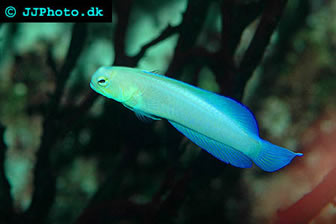Jawfish
Jawfish belong to the family Opistognathidae in the order Perciformes. Fishbase currently lists 60 different species divided into 4 genera: Lonchopisthus, Merogymnoides, Opistognathus and Stalix.
Jawfish in the aquarium
Several species of jawfish have been successfully kept by aquarists. It is important to use a suitable sandy substrate in the aquarium since these fishes need to be able to dig out vertical burrows. Ideally also include tiny stones, shell pieces and other types of naturally occurring elements. You can for instance mix 3 parts fine sand with 1 part course material. The substrate in the aquarium should be at least 2-3 inches (5-7.5 cm) deep.
The jawfish will claim the area around its burrow as its territory. How much territory each fish will claim depends primarily on the species; some will live only a foot (30 cm) apart in the wild while others place their burrows at least 3.3 feet (1 meter) from each other.
It is a non-aggressive fish that should not be kept in the same aquarium as aggressive species. You can for instance combine jawfish with small, friendly fish and non-aggressive invertebrates.
Since the jawfish tend to dig a lot, they can disrupt undergravel filters. If you absolutely wish to use an undergravel filter, create a barrier between the filter and the top layer of sand. You can for instance use mesh or fibreglass.
The aquarium must have a secure lid because the jawfish is a powerful jumper.
Geographical range, habitat and habits
Jawfish are found in the Atlantic, Indian Ocean and Pacific Ocean. In the Atlantic, they live in the central and western part. Jawfish only occurs in saltwater; never in brackish or fresh water.
Jawfishes live in shallow reefs areas and will dig out burrows for themselves in sandy substrate. The fish creates a burrow by filling its mouth with sand and spitting it out elsewhere. It will also produce a special slime that is used to stabilize the burrow. The fish will then enter its burrow tail-first and stay inside with only its head exposed. It will feed on plankton and other small aquatic creatures and immediately seek shelter in the burrow if it feels threatened. The jawfish claims the area around its burrow as its territory.
Watching a jawfish work is fascinating because it will continuously rearrange sand, shells, tiny stones and other items to create the perfect burrow with a fitting entrance.
Feeding jawfish
The jawfish is a carnivore creature that feeds on benthic and planktonic invertebrates. During feeding, the jawfish will dash in and out of its burrow.
When kept in the aquarium, one of the easiest ways of feeding the jawfish is to fill a turkey baster with water and small pieces of food (e.g. brine shrimps, krill and minced shellfish) and discharge the food near the burrow.
Don’t worry if your jawfish refrains from eating for a week or so when it has been moved to a new aquarium. It can normally be coaxed into eating after a while if served live food, e.g. brine shrimp.
Jawfish Articles:
Yellowhead Jawfish – Opistognathus aurifrons
Anthias
Aquarium Chillers
Basses
Batfish
Blennies
Butterflyfish
Cardinalfish
Clown fish
Corals
Damselfish
Files
Goatfish
Gobies
Gorgonians
Grammas
Groupers
Grunts
Hawkfish
Jawfish
Jellyfish
Lionfish
Dragonets
Mantis shrimp
Marine angelfish
Marine Catfish
Moray eels
Nudibranch
Octopus
Pipefish
Protein skimmers
Pufferfish
Rabbitfish
Rays
Snappers
Scorpionfish
Sea Anemones
Sea horses
Sea Stars
Shark Fish
Shrimps
Snails
Squirellfish
Surgeonfish
Triggerfish
Wrasses

